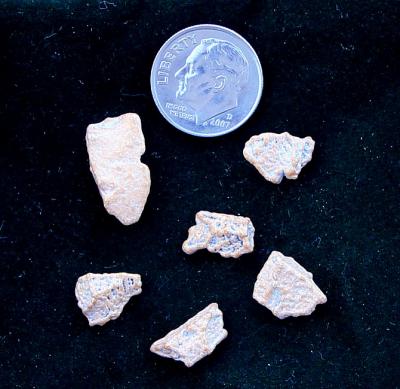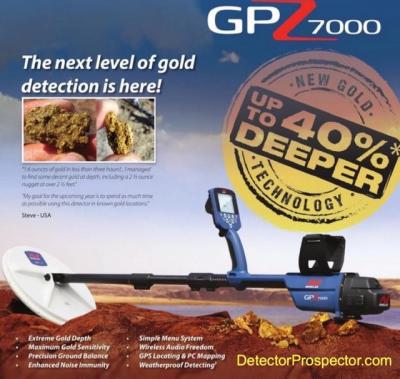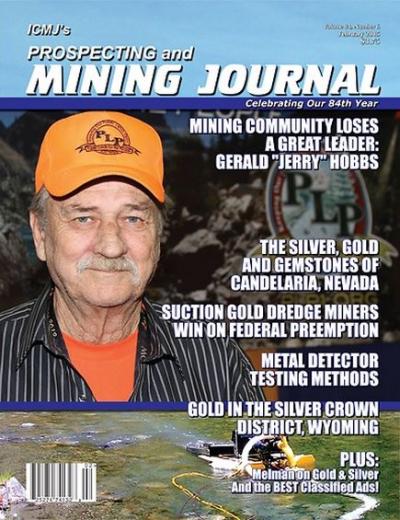-
Posts
883 -
Joined
-
Last visited
Content Type
Forums
Detector Prospector Home
Detector Database
Downloads
Everything posted by Reno Chris
-
You stated PI had reached it's limits, knowing what you know about the 7000 do you think the ZVT technology has room to grow? yes in some ways it is like going back and resetting the clock to the SD 2000, there certainly will be improvements and additions in the future, however the performance levels and what features may be included - I haven't the slightest idea and your guess is as good as mine. Also, coils: whats the story with this detector and coils? Is there the potential for an aftermarket or is there anything like a chip that makes them Minelab only? Is there a limit to how slim an elliptical coil can be, does that main central winding need to be more or less round for some reason or another? accessory coils are coming, however I don't think they're available right at this moment. As far as accessory coils, that would be something I really couldn't answer. How is it swinging this thing all day? Does the added weight bear down on a guy even with a harness and bungee? Having never used a CTX is the new form factor better at carrying the weight? I did swing this detector around without any bungee for most the time I had it. It was a bit on the heavy side, but with the bungee it should be no problem. if you have to swing on hillsides and other steep areas where a bungee doesn't work so well then all I can tell you is it's kind of heavy but I was able to swing it. For shallow stuff (small, spongy, crystalline, etc) how does the 7000 compare to a good VLF like the GMT or GB2? I know people won't like this question for a long list of reasons but it's inevitable so I'm asking. the answer to this depends a lot on what kind of ground we are talking about. I have had my GB2 in places where you simply couldn't operate it because the ground was so noisy. I will assume you mean in ground that is mild where one can actually use a VLF easily - on the very very tiniest gold such as something less than half a grain then the VLF will probably have an advantage in very mild soil. However things of larger size it will punch down much, much deeper. I dug a piece of wiry mossy gold that weighs a little more than half an ounce after all the rock , iron oxides and other junk was removed and 18 inches. I would guess that my GB2 would not be able to see that more than about at 6 to perhaps 8 inches deep.
-
To be clear, I am not asking about the dime. I know what a dime is.
-
I've done a lot of IDs, but for fun and to make a point as to the ease of correctly identifying stuff from a photo, I thought I would post this, and ask - What is this stuff???...
-

Guess The Price of the GPZ 7000 ?
Reno Chris replied to Sourdough Scott's topic in Minelab Metal Detectors
It would be interesting to see the price in other currencies and then the conversion into US dollars. -

Help Identify Strange Rocks
Reno Chris replied to Rick Watkins's topic in Rocks, Minerals, Gems & Geology
They grow in mud in layers like shells. See: http://en.wikipedia.org/wiki/Concretion -

Open Source Metal Detector
Reno Chris replied to jasong's topic in Metal Detector Advice & Comparisons
I also would like to see Steve break this into a separate thread. I think we are talking about several things here - hardware tinkering, software programming and use of existing software to adjust the settings and performance. I just don't see any more than a very small number who have any interest in tinkering with the hardware, adding boards, messing with the electronics. Very few do that kind of thing with their cell phones either. Writing programs to do the signal analysis - I dont think that is of interest to any but a very small number either. How many folks actually write their own cell phone aps? However, using the programs in the detector to alter settings and responses - that's a trend that has been going on a long time, both in VLF and PI detectors. The big step of the GPX series over the GP series is greater flexibility to set or program the detector to optimize its performance. This trend continues in the newer machines. However prospectors tend to be a cantankerous bunch and many complained that the GPX 5000 has too many settings and possibilities and they are never quite sure of what to use. -

Help Identify Strange Rocks
Reno Chris replied to Rick Watkins's topic in Rocks, Minerals, Gems & Geology
Really hard to say from just a photo, but it appears to be some kind of concretion. -

Open Source Metal Detector
Reno Chris replied to jasong's topic in Metal Detector Advice & Comparisons
All I can say is that I've never seen a multi-frequency unit that is as nearly hot as a single frequency unit can be - so there is a reason why the multi-frequency machines currently on the market are not that hot on smaller gold. If you have a single frequency, you can tune the coil to work best with that frequency. If you have multi-frequency then you must of needs make compromises to run the coil at a variety of frequencies. Just in the same way that the mid-frequency do-it-all type design needs to be one with many compromises to make coin, jewelry, relic and gold hunters happy - sort of at least. The result is that these machines do everything sort of OK, but they do nothing great. We have loads of machines with lots of compromises to "sort of" do it all. I would way rather see the gold racer as a dedicated gold machine that does gold prospecting great. Because nuggets tend to be small and commonly located in highly mineralized ground, gold detecting is perhaps the most challenging metal detector application for the engineers who design these machines. Honestly, most prospectors are not DIYers who want to spend hundreds of hours in the garage testing,re-programming, tweaking and then retesting their machines in an endless do-loop of forever fiddling. There are guys like that and I say more power to them, but they are a tiny, tiny segment of the market, like you can count them on your fingers. That's why the makers of detectors have little interest in that market. For those who want a do-it-all machine, there are a huge number of choices, all very similar, some makers make multiple machines that fall into this category. The Makro Racer is one of these. For the serious prospector who wants to get out in the field and go find gold, when it comes to a VLF, he will look for a dedicated, no compromise IB detector designed for detecting gold. A detector that can see a nugget of 0.05 grams, handles mineralized ground as well as possible and gives a decent discrimination result. Currently there are not that many choices in this market segment and all the designs are more than 10 years old and have frequencies higher than 50 Khz. We could use another entry into that market. -
The older machines did not employ more modern high gain, low noise circuits. I think there were some serious quality control issues with the Gold Strike - I've heard stories of machines that were fine and others that had a horrible lack of sensitivity. It was made in those last chaotic years before FTP took over the company. A state of the art modern Induction Balance (VLF type) machine with 30 Khz might be really good.
-
It would be nice if they made the Gold Racer to operate at around 30 Khz. Its a niche that is not well filled by anything on the market - There are higher Khz machines, there are plenty of lower. Make it hot on smaller gold and with the lower Khz (as compared to the really high Khz machines), maybe not quite as sensitive to ground noise, not quite as sensitive to to the tiniest gold but it could be a very good machine and if made in the form of the racer which is good ergonomically, I think could be real successful.
-
Great. Now the IRS will want taxes on $20,000 of income. Yah, they are supposed to wait until you sell the gold and actually have income from it, but hey, do you think they will wait?
-

Giant Man Cave - With Gold Display
Reno Chris replied to goldbrick's topic in Detector Prospector Forum
Did you go next door and see the gold display? -

Steve's 2013 Alaska Gold Adventure
Reno Chris replied to Steve Herschbach's topic in Detector Prospector Forum
Having seen that big nugget in person, I can say that it's a really beautiful piece of gold. -
Steve - Did you ever find out if one can just purchase the velcro bunjii attachment that is included in the Pro Swing but can be used on pretty much any detector shaft (including the 2300)? I'd like to purchase a couple of them and that conference might be just the place to ask that question. I'd like to put one on a few detectors and just leave them there rather than trying to remember to move it from detector to detector.
-

Steve's 2013 Alaska Gold Adventure
Reno Chris replied to Steve Herschbach's topic in Detector Prospector Forum
Sure was a lot warmer than last year! -

GPZ 7000 40% More Depth - Really?
Reno Chris replied to goldbrick's topic in Minelab Metal Detectors
You only have to rewind back to last year and the SDC 2300. Many, many folks claimed their 5000s with an 8 inch coil was every bit as good on small gold as the SDC and it was way too expensive to be "worth it". Further testing showed the SDC was clearly better on small shallow stuff, but there are still folks who don't believe. No worries - you don't have to buy a 2300, no one will make you do it. Heck, there are still a few that think the SD 2000 is as good as any detector ML has made. Look in at some of the Aussie forums - they have very little info, but the complainers have assumed the worst right down the line and are crying and sobbing just as Steve has predicted. -
So a few minutes ago I read - on an Aussie gold forum no less - Many of you know that I am the associate editor of the ICMJ magazine - AKA - The Prospecting and Mining Journal. We've been printing issues since 1931. However, while I write a lot of the articles, I don't normally see the ads (just not my job), and I've not got my issue in the mail yet. However some folks have got theirs and apparently this gent who lives in Arizona has his copy for this month. I'm looking forward to seeing it! The photo image version of the magazine is not yet on the internet either, but it should be in a few days. ICMJ Prospecting & Mining Journal February 2015 (Vol. 84, No. 6)
-

A Tale Of Gold, Greed, And Outlaws
Reno Chris replied to Steve Herschbach's topic in Detector Prospector Forum
If he never cheated anyone, why did he run and do his best to hide? Gold really does not corrupt people, but if you are a corrupt person, significant amounts of gold will bring that out of you and make that corruption very obvious. -
Hi Fred - Sierra Valley (like Loyalton, Sierraville, Beckworth) and Quincy are at least 20 miles apart, so I have to say I am highly skeptical that a lightening strike at least 20 miles away could break a detector. Who knows for sure, but it sounds more like a capacitor that had problems to begin with to me - and bad capacitors do exist. Some years back Dell installed a bunch of them in their computers, lost a lawsuit because they kept failing and eventually paid out over 300 million dollars (My son used to repair Dell Products and about half the repairs he did were bad capacitors). If a distant lightening strike can break a detector, the same kind of surge through the circuits when you swing over a very large metal object that overloads the detector could do the same. The other thing is that EMI decreases in power by the cube of the distance. So The EMI of anything (powerlines, etc.) decreases rapidly as you get away from it. Lightening releases huge amounts of energy, but from many miles away, the amount is far less.
-
No, Lightning EMI cannot fry your detector. If you and your detector are actually struck by the lightening itself, yes, that certainly can fry your detector. The spike you hear moves at the speed of light, the same as the lightening flash (and normally you cannot see the flash during the daytime). The noise of the rumble or boom you hear moves at the speed of sound. When there are only a couple seconds between the EMI spike and sound of the boom, you need to turn off your detector and seek shelter, not because the EMI will fry your detector, but because you don't want to be struck by lightening. Eliminating the lightening spikes is really difficult and I think you can commonly hear them from strikes 50 miles away.
-

Garrett ATX Strip Down & Rebuild
Reno Chris replied to Steve Herschbach's topic in Garrett Metal Detectors
Powder coating is very cool and durable to abuse, but good old Krylon is cheaper. -
There are lots of different levels of EMI and it can come from different sources. The auto tune can handle low to moderate EMI, but if you are hunting in high EMI conditions like next to power lines or in a suburban area with homes around you, no, the autotune will not handle that. You'll need to put on a DD coil and use cancel mode. Check your operators manual for more info. http://www.minelab.com/__files/f/22591/Instruction%20Manual%20GPX%204800-5000%20%284901-0096-2%29.pdf
-

Hey Chris Ralph (or Steve) - ICMJ Placerville Summit?
Reno Chris replied to deathray's topic in Detector Prospector Forum
Steve is correct. Spring of 2016. We will have details to announce about a year from now.




